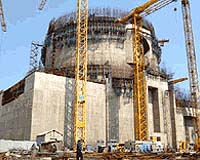 Russia and India have upgraded their unique cooperation in building civilian nuclear facilities by initializing an intergovernmental agreement on the construction of four additional energy units at the Kudankulam nuclear power station in Tamil Nadu and on joint work at other sites.
Russia and India have upgraded their unique cooperation in building civilian nuclear facilities by initializing an intergovernmental agreement on the construction of four additional energy units at the Kudankulam nuclear power station in Tamil Nadu and on joint work at other sites.Deputy Director of the Federal Atomic Energy Agency Nikolai Spassky and head of the Indian Nuclear Power Corporation S.K. Jain confirmed the viability of this agreement in New Delhi on Feb. 11. Now the document has to go through the last channels and be approved by the heads of state.
For Russia, the Indian order is a victory in the struggle for a new segment of the world market. Russia has won a big contract for its energy and industry sector. In turn, construction of new energy generating capacities is very important for the rapidly developing Indian economy. This event is also of global significance as evidence of the nuclear industry's revival.
The prospect of building nuclear reactors in India is of great importance for Russia. It is clear that this is not going to be the last order, but may be extended to 10 or even more units at other sites. There are some restraining factors, though. India has not yet signed the Nuclear Non-Proliferation Treaty, and this fact is becoming sensitive when it comes to relations with nuclear suppliers.
Russia is going to build VVER-1000 reactors (or WWER -- Water-Water Energy Reactor, 1000 megawatt electric power) on India's new sites that encompass the latest achievements of its nuclear energy industry. Fifty three reactors of this type, including 14 in Russia, are operating without a hitch. Their aggregate service life exceeds 1,000 reactor years. Two units are built simultaneously to save money. The latest double unit was integrated into China's national energy system last fall.
Independent and International Atomic Energy Agency experts believe that this Russian model is one of the safest in the world. Compared to nuclear reactors in European countries, the United States and Japan, Russian units are a better value for the money.
The nuclear power plant in Kudankulam has already stood a serious test when it was hit by a tsunami caused by an earthquake in the Indian Ocean. The dam was partially washed out, but it protected the plant at the exit into the open sea. The plant's location was chosen very well -- it stands behind Sri Lanka, which absorbs the onslaught of the ocean. The Russian project provided for other safety mechanisms that would prevent water from spreading on the plant's site. Russian experts will do even better on new Indian sites.
Russia and India started nuclear cooperation in the 1970s-1980s when they signed two documents -- an agreement on scientific and technical cooperation in civilian nuclear energy (1979) and an agreement on cooperation in building nuclear power plants in India (1988). In November 2001 they signed a memo on the fundamental principles of cooperation in building the Kudankulam nuclear power plant.
The first scoop of concrete was poured into the foundation of the first unit of the Kudankulam nuclear plant in the Tirunelveli district in Tamil Nadu on March 31, 2002. According to estimates by Rosatom, the Federal Atomic Energy Agency, the first unit will be commissioned in late 2008, and the second one will become operational in 2009.
Source: United Press International| by Tatyana Sinitsyna
No comments:
Post a Comment